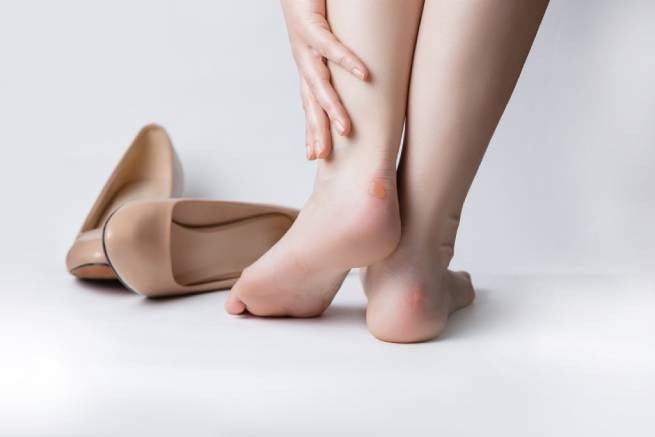Hot weather strongly encourages you to switch from boring sneakers and shoes to open sandals. It's time to get your feet in order and finally get rid of unattractive dry calluses.
In addition, dry calluses can cause serious problems over time, so their removal should not be put off until later.
How to tell if it's a dry callus
In some people, for various reasons, there is an overgrowth of the stratum corneum of the epidermis, called hyperkeratosis. Horny areas of skin on the legs mercilessly spoil their attractive appearance and can cause serious problems – pain, the appearance of cracks and infection, the inability to put on your favorite shoes. And getting rid of them is not so easy.
Dry callus is a type of hyperkeratosis with certain characteristics. It can occur in men and women at any age – both young and old. This is a limited area of rough skin resulting from exposure, pressure or friction. Dry calluses may appear on the heels or fingers, feet or hands.
Under the influence of increased load or friction, accelerated division of skin cells occurs. Dying cells do not have time to peel off, they become denser and form a dense thick layer. Usually, dry callus is small and round, with clear outlines. The seal itself is not dangerous; it only spoils the beauty of delicate skin. But over time, the yellowish tubercle begins to cause concern. Growing deeper, it takes the shape of an inverted cone, the top of which, the so-called rod, causes pain with its pressure. In addition, rough skin tends to crack at every opportunity, and infection gets into the wounds and causes painful inflammation.
What causes dry calluses?
Sometimes the appearance of hardened skin appears to occur on its own. In fact reasons for its appearance there are many:
- uncomfortable tight shoes, the wrong size or too narrow, rough internal seams;
- increased sweating of the feet;
- high heels, too thin shoe soles;
- walking barefoot for a long time;
- flat feet;
- fungal diseases;
- joint deformation;
- overweight;
- circulatory disorders.
Dry calluses are often caused by profession – they worry ballerinas and runners, dancers and representatives of “standing” professions.
They have a tendency to form painful lumps diabeticsAs a rule, the lump appears on their toe, usually the big toe. And if dense tubercles appear under the little finger, this is a signal of trouble in the functioning of internal organs. On the right leg they indicate a dysfunction of the liver, on the left – a disturbance in the activity of the cardiovascular system. Another reason is the presence of arthritis.
Diagnostics
To successfully get rid of dry callus, you need to correctly differentiate* various formations:
- Corns. Dry callus on the foot has much in common with them, but differs in size and clear rounded outline. The cause of corns is also uncomfortable shoes, flat feet and high heels. They are usually located at the base of the toes and in the heel area. These formations do not have a core and are quite easy to deal with at home.
- Dry calluses bThey are superficial and deep. The first ones appear in place of painful blisters filled with liquid – fresh calluses. Most often they are the result of updating fashionable shoes or ignoring socks when wearing sneakers. Careless treatment of dropsy or its absence leads to the gradual death of skin cells as the wound heals, the formation of a dense layer of epidermis and the appearance of dry calluses on the legs in this place. They can be located at the base of the toes, between them, on their top, on the foot – wherever wet calluses are located. At this stage, it is still quite easy to deal with a dry callus on the toe or sole, but ignoring the problem leads to its aggravation.
- Dry callus with a stick. Left unattended, dry calluses on the feet tend to grow deeper. Gradually, a kind of root forms, penetrating further inside and causing discomfort during long walking. As the dry callus with the stem grows, it takes on a cone-shaped shape and causes more and more concern. It will no longer be possible to cope with it with the help of pumice stones and warm baths; more radical methods will be needed.
- Plantar wartIt looks like a dry callus on the foot, but requires a completely different method of treatment. It is necessary to know the distinctive features of a wart and a dry callus with a stem in order to choose the most effective method for getting rid of an unwanted guest. The wart does not have keratinized tissue and is saturated with nerve endings and blood vessels. When it is damaged, a drop of blood appears, and similar formations may be located nearby. In contrast, a dry callus on the toe or sole is not sensitive, self-contained, and does not bleed when cut or pricked.
The doctor will accurately determine whether it is a dry callus with a ridge or an unpleasant wart, and will suggest the best way to get rid of the anomaly. You can try to get rid of corns, for example, or superficial dry calluses at home, but old dry calluses that have a core should only be removed by a specialist.
Dry callus – treatment
There are several ways to get rid of dry calluses. It is best if a podiatrist or an experienced professional cosmetologist acts as an assistant in this difficult matter.
- Cryotherapy – a virtually painless procedure lasting 40-50 seconds. A boring dry callus on a finger or foot is frozen with liquid nitrogen along with the callus, and after some time it safely disappears. Fresh, delicate skin will completely hide its location.
- Laser – an effective and painless remedy, removal of dry calluses occurs right before your eyes.
Hardware pedicure – dry callus on the toe lends itself perfectly to this method. Using various attachments, the master successfully removes the stratum corneum of the skin, and then “drills out” a cone-shaped dry callus on the finger using tools.
Treatment at home
If dry calluses on your feet are not too old, and most likely there is no core there, try to get rid of them at home. There are many methods:
- soap and soda baths, lasting 30-40 minutes, preferably done daily. Many people advise treating the legs with pumice every time, but be patient and don’t do this. After 6-8 procedures, the dry callus on the toe will disappear on its own, leaving no trace;
- keratolytic gel, which is purchased in pharmacies, perfectly softens dry calluses on the finger and promotes the gradual exfoliation of the stratum corneum. The most popular is 10% salicylic ointment, it contains benzoic acid;
- special patch for dry calluses – an excellent remedy for treating them at home. Before using it, dry calluses on your feet should be steamed well, wipe thoroughly and apply the patch only to the affected area. Three days later, after removing the effective remedy, the dry callus on the foot or toe will only be a memory. It is especially convenient to use the patch when the dry callus is located on the toe or hand.
When using ointments, gels or patches, it is recommended to carefully ensure that the products do not come into contact with healthy skin. To do this, it is convenient to cover the required area of skin with a regular adhesive plaster, cutting out a hole in it for a dry callus on a finger, foot or heel. After applying the cream, you need to apply another layer of protective plaster on top.
ethnoscience
Our grandmothers knew very well how to get rid of dry calluses, so some of their secrets help in our time. What does traditional medicine offer us? Effective removal of dry calluses can be achieved by seemingly simple means:
- Cut an aloe leaf lengthwise and bandage it to a dry callus. In the morning it will be possible to remove, if not all, then a significant part of the dry callus on the foot. Repeat several times until the keratinized area completely disappears;
- propolis is used in the same way;
- Peel and cut the onion, pour in regular 9% vinegar and leave for a day. Complete removal of dry calluses will require several days of treatment – you can apply onions soaked in vinegar twice a day;
- tease your husband with the smell – make a compress of lard and garlic at night. The product is effective even for dry calluses with a core, however, if it is small.
- Even a dry callus, the treatment of which is difficult due to the presence of a stem, will not resist a mixture of black bread, sugar and vinegar. It will sting a little, but a couple of procedures are enough to cure it;
- An ordinary slice of lemon will work better than a patch for dry calluses. Before applying it, the legs should be steamed in warm water;
- A pleasant and effective remedy is vegetable oil. It can be olive, flax or corn. How to get rid of dry calluses this way? You need to wear socks soaked in oil at night. Wrap them with a plastic bag on top and put on a second pair of socks. In the morning, just wash your feet with warm water and enjoy their tenderness. If the dry callus on the foot does not disappear, repeat the procedure again. Instead of the above oils, you can use a mixture of glycerin and castor oil, taken in equal quantities.
The listed remedies will certainly help get rid of dry calluses and restore the beauty and natural tenderness of your feet. But be careful – do not try to cut out a dry callus with a stem yourself. Your actions will probably not bring the desired result, and an introduced infection can aggravate the problem. Contact a specialist, and dry calluses will stop bothering you. And careful foot care and proper selection of shoes will help avoid problems in the future.
*Differential diagnosis (from the Latin differentia “difference”, “difference”) in medicine is a diagnostic method that excludes diseases with similar symptoms that are not suitable for any facts, which ultimately should reduce the diagnosis to the only probable disease.







More Stories
Gambling: In the first half of 2024, the Greeks "put it on the line" 21.2 billion euros
"Death number" pedestrian on Iera Odos (video)
Traffic surveillance cameras never "don't go on vacation": fines of 200 euros